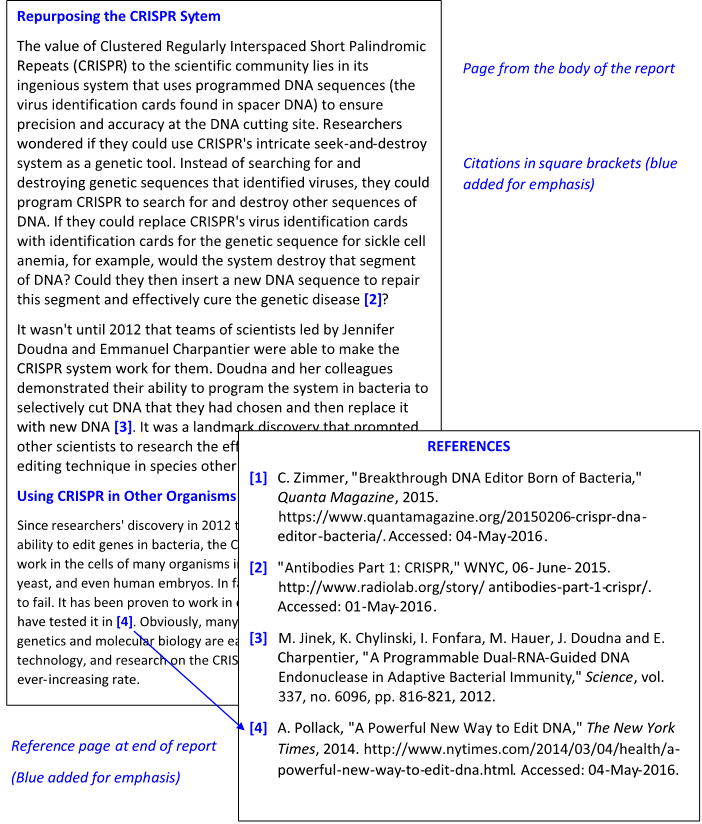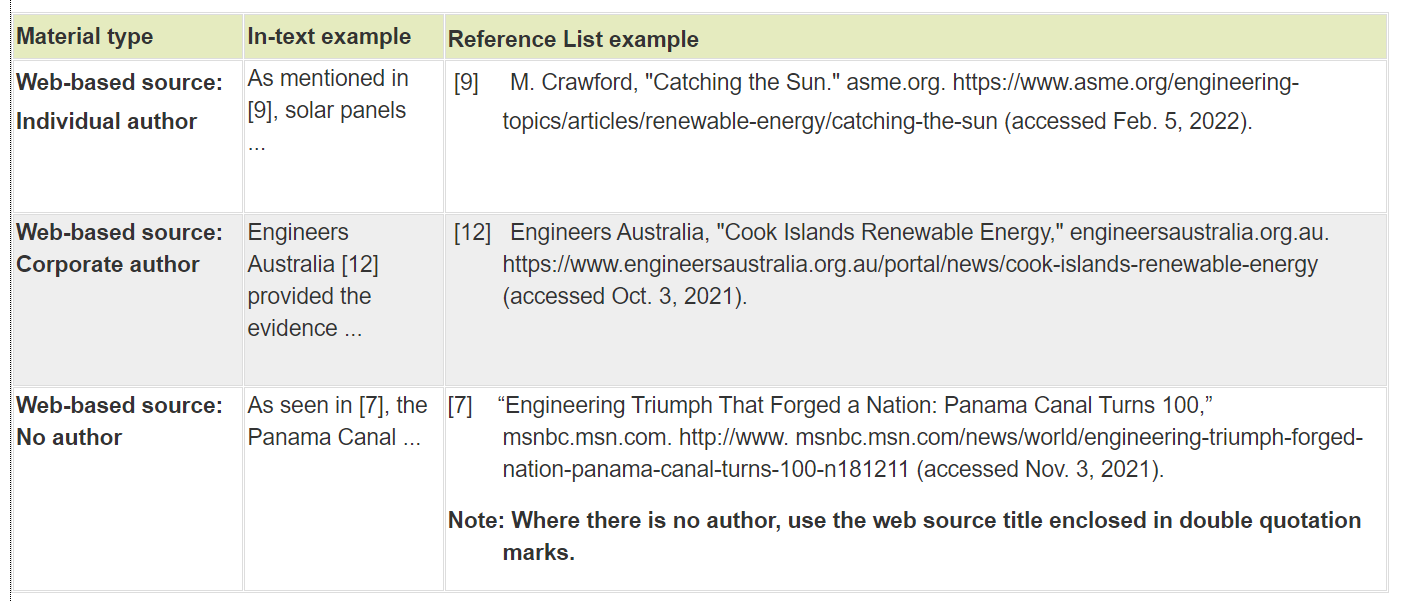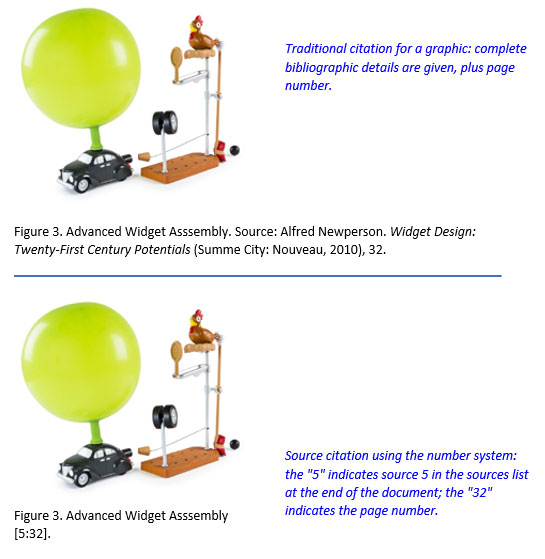When you write a researched technical document (techdoc), you can and should borrow information like crazy. However, to make it legal, all you have to do is "document" it. If your techdoc makes you sound like a rocket scientist but there's not a single source citation in it and you haven't even taken college physics yet, people are going to start wondering. (In Night Court, you'd be guilty of plagiarism. Fine—an F on the paper in question.)
However, if you take that same techdoc and load it up properly with source citations (those little indicators that show that you are borrowing information and that show from whom), everybody is all the more impressed—plus they're not secretly thinking you're a shady character.
A documented techdoc (one that has source indicators in it) says to readers that you've done your homework, that you're up on this field, that you approach these things professionally—that you are no slouch.
Resources for Documentation
Note: For format on citing books, articles, Internet and other information sources, see these resources:
Research and Citation Resources. Overview from the Purdue OWL with links to specific systems.
Citing Sources Styles. From Austin Community College.
APA (Author Date System)
APA Documentation. Austin Community College (Austin, Texas)
APA Style. American Psychological Association.
IEEE (Number System)
IEEE Citation Style. From Murdoch University, Murdoch, Western Australia.
6.2: Setting Up A Reference List – Sample Entries (IEEE). From LibreTexts: Humanities.
IEEE Reference Style Guide for Authors. IEEE
MLA (Author Page System)
MLA Documentation. Austin Community College (Austin, Texas)
Here are some resources on plagiarism:
Plagiarism. From the Purdue OWL.
Paraphrasing and summarizing. Methods of avoiding plagiarism. From the Purdue OWL.
Number System of Documentation
Caution: Shown here is a modified, simplified version of the IEEE documentation system. Make sure that the documentation style you use conforms to the system required by the journal, publisher, or instructor you write for.
If you've taken other college writing courses recently, you have probably been exposed to other documentation systems—specifically the MLA, or works-cited system. The problem with that system is that it is rather limted to the literature field. Unfortunately, it is not widely used outside that field—especially not in technical and scientific fields.
One of the more common systems used in technical fields is the number system. It's too bad you have to learn a different system, but at least this one is easy to learn and use. The citation-sequence version of the CSE (Scientific) Documentation (see the link above) is one of the specific incarnations of the number system. (Notice that here that we use brackets, not parentheses for the source indicators.)
In this number system, you list your information sources alphabetically, number them, and put the list at the back of your techdoc. Then in the body of your techdoc, whenever you borrow information from one of those sources, you put the source number and, optionally, the page number in brackets at that point in the text where the borrowed information occurs. The following examples show how this system works:
- [4] would refer to source 4 in the list.
- [4:231] would refer to page 231 of source 4.
- [4:231-235] would refer to pages 231 through 235 of source 4.
- [4;7] would indicate that the information was borrowed from source 4 and source 7.
What to Document
This question always comes up: how do I decide when to document information—when, for example, I forgot where I learned it from, or it really seems like common knowledge? There is no neat, clean answer.
You may have heard it said that anything in an encyclopedia or in an introductory textbook is common knowledge and need not be documented. However, if you grabbed it from a source like that just recently—it really isn't common knowledge for you, at least not yet. Document it! If you just flat can't remember how you came by the information, then it has safely become common knowledge for you. (What's going on here is that we're trying to protect the efforts of those poor devils who originated the information we want to borrow—give 'em a break, give 'em their due!)
One other question that is often asked: do I document information I find in product brochures or that I get in conversations with knowledgeable people? Yes, most certainly. You document any information, regardless whether it is in print, in electronic bits, magnetic spots, or in thin air.
How to Place the Source Indicators
It's tricky deciding exactly where to place the source indicators—at the beginning of the passage containing the borrowed information, at the end? If it makes sense to "attribute" the source (cite the name of the author or the title of the information), you can put the attribution at the beginning and the bracketed source indicator at the end (as shown in the following).

Example page with bracketed source indicators and corresponding source list
In the number documentation system, the code numbers in the text of the techdoc are keyed to the references page. For example, [6:5] in the body of the techdoc indicates that the information came from source 6 (in References), page 5. Notice that the attribution of the quotation indicates the beginning of the borrowed information and the bracketed source indicator marks the end.
How to Set up the Sources List
A bit more challenging is setting up the list of information sources—that numbered, alphabetized list you put at the end of the document. (The context here is still the number system.) The best way to learn is to use examples. The following examples show you how to handle books, government reports, articles from magazines and journals, encyclopedia articles, and personal interviews.
Internet and Web information sources. For format on citing Internet and Web information sources, see any of the resources listed above. As you will see, there are quite a few variations. However, a simple functional practice would be in this order:
- Author name, last name first. If that's not available, use the organization's name, followed by a period.
- Next, the title of the page.
- After that the publication date of the web page, if available; otherwise, use the "N.d" indicator.
- Next, the full URL of the page.
- And finally an indication of the date you accessed the page, for example, Accessed June 6, 1988.

Source: https://libraryguides.vu.edu.au/ieeereferencing/webbaseddocument#s-lg-box-wrapper-10146966. Thanks to Muraco Kyashna-tocha
Books. For books, put the name of the author (first name last) first, followed by a period, followed by the title of the book in italics, followed by a period, followed by the city of the publisher, followed by a colon, followed by the publisher's name (but delete all those tacky "Inc.," "Co.," and "Ltd." things), followed by the year of publication, ending with a period. In this style, you don't indicate pages.

Example: book entry
Magazine and journal articles. Start with the author's name first (last name first), followed by a period, then the title of the article in quotation marks and ending with a period, followed by the name of the magazine or journal in italics, followed by a period, followed by the date of issue of the magazine the article occurs in, followed by the beginning and ending page. If the article is spread out across the magazine, you can write "33+." or "33(5)." The (5) in the preceding is an estimate of how many pages the article would be if it were continuous.
If there is no author, start with the article or book title. If there are two authors, add "and" and the second author's name, first name first. If there are too many authors, use the first one (last name first), followed by "et al.," which means "and others."

Example: entry for a journal article
Note: You may have seen complex entries indicating volume and issue numbers. While those may be required in some contexts, normally you can simplify things and just include the issue date. But ask!
Encyclopedia articles. Encyclopedia articles are easy! Start with the title of the article in quotation marks ending with a period, followed by the name of the encyclopedia (in italics if you have it; otherwise, underline), followed by the period, then the year of the edition of the encyclopedia.

Example: encyclopedia entry
Reports. With reports, you're likely to dealing with government reports or local informally produced reports. With most reports, you may not have an individual author name; in such cases, you use the group name as the author. For government reports, the publisher is often the Government Printing Office; and the city of publication, Washington, D.C. Also, for government documents, you should include the document number, as is shown in the following example.

Example: entry for a report
Personal interviews, correspondence, and other nonprint sources. With these sources, you treat the interviewee or the e-mail or letter writer as the author, follow that name with the person's title, followed by a period, then the company name, followed by a period, then the city and state, followed by a period, then what the information was ("Personal interview" or "Personal correspondence") followed by a period, ending with the date.

Example: entry for unpublished information
Interest group brochures. For these kinds of information sources, treat the interest group name as the author, followed by a period, use the title of the brochure, followed by a period, ending with a date if you can find one (otherwise, put "N.d.").

Example: entry for an interest group brochure
Product brochures. For these kinds of information sources, treat the company name as the author, followed by a period, use something identifying like the product name (including the specific model number), followed by anything that seems like the title of the brochure, followed by a period, ending with a date if you can find one (otherwise, put "N.d.").

Example: entry for a product brochure
Documenting borrowed graphics. It's certainly legal to copy graphics from other sources and use them in your own work—as long as you document them. You indicate the source of a borrowed graphic in the figure title (caption), which is located just below the graphic. In the figure title, you can show the source of the graphic in two ways—the long traditional way or the shorter way that uses the format of the number system:

I would appreciate your thoughts, reactions, criticism regarding this chapter: your response—David McMurrey.
